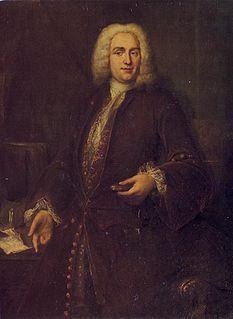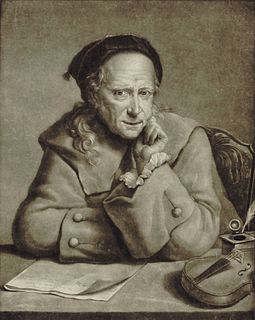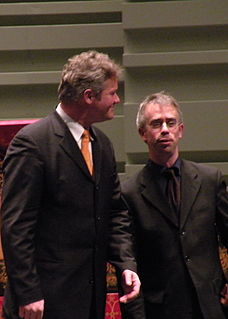Related Research Articles

The viola d'amore is a 7- or 6-stringed musical instrument with sympathetic strings used chiefly in the baroque period. It is played under the chin in the same manner as the violin.

Marin Marais was a French composer and viol player. He studied composition with Jean-Baptiste Lully, often conducting his operas, and with master of the bass viol Monsieur de Sainte-Colombe for six months. In 1676 he was hired as a musician to the royal court of Versailles and was moderately successful there, being appointed in 1679 as ordinaire de la chambre du roy pour la viole, a title he kept until 1725.

Francesco Antonio Bonporti was an Italian priest and amateur composer.

Joseph Bodin de Boismortier was a French baroque composer of instrumental music, cantatas, opéra-ballets, and vocal music. Boismortier was one of the first composers to have no patrons: having obtained a royal licence for engraving music in 1724, he made enormous sums of money by publishing his music for sale to the public.

Nicolas Chédeville was a French composer, musette player and musette maker.

Jacques-Martin Hotteterre, also known as Jacques Martin or Jacques Hotteterre, was a French composer and flautist who was the most celebrated of a family of wind instrument makers and wind performers.

Michel de la Barre was a French composer and renowned flautist known as being the first person to publish solo flute music. He played at the Académie Royale de Musique, the Musettes and Hautbois de Poitou and the courts of Louis XIV and Louis XV.

Carlo Tessarini, was an Italian composer and violinist in the late Baroque era.
Jean-Baptiste Barrière was a French cellist and composer. He was born in Bordeaux and died in Paris, at 40 years of age.
Louis-Gabriel Guillemain was a French composer and violinist.

Pierre Hantaï is a French conductor and harpsichordist.

Michel Lambert was a French singing master, theorbist and composer.
Pièces de viole were collections of suites for bass viol and usually continuo written by several French Baroque composers, most notably Marin Marais, whose five Livres form a core of the viol repertoire. Early pièces did not include continuo parts; examples of these may be found in the oeuvres of Sieur de Sainte-Colombe and Nicolas Hotman. Derived from lute and theorbo music, they often featured preludes sans mesures, and virtuosic bowed trills, whilst remaining French in their dance rhythms and melodies. Formally they also mirrored the pièces de clavecin being written by virtuoso harpsichordists. Marais and his contemporaries further established a uniquely French tradition of virtuosic pieces for viol and continuo. The pièces were typically written in dance forms like the Allemande, Gavotte, Sarabande, and Gigue, augmented by a Prélude or a Fantaisie and with additional character pieces like Plaintes and Tombeaux.

Louis-Toussaint Milandre was a French composer, violinist, viol and viola d'amore player in the court chamber music of Louis XV of France.

The Paris quartets is a collective designation for two sets of Chamber music compositions, each consisting of six works for flute, violin, viola da gamba, and continuo, by Georg Philipp Telemann, first published in 1730 and 1738, respectively. Telemann called his two collections Quadri and Nouveaux Quatuors. The collective designation "Paris quartets" was only first bestowed upon them in the second half of the twentieth century by the editors of the Telemann Musikalische Werke, because of their association with Telemann's celebrity visit to Paris in 1737–38. They bear the numbers 43:D1, 43:D3, 43:e1, 43:e4, 43:G1, 43:G4, 43:g1, 43:A1, 43:A3, 43:a2, 43:h1, 43:h2 in the TWV.
Charles-Henri de Blainville was a French composer, cellist, pedagogue and music theorist.

Gabriele Leone was an Italian musician and composer who lived in Paris during the middle and later part of the 18th century. A virtuoso on the violin and mandolin, he wrote an early mandolin method, Analytical method for mastering the violin or the mandolin in 1768 and composed for both instruments. He was an early teacher of the duo method, an advanced technique which would reappear in the 20th century, taught by Giuseppe Pettine in the United States.
Jérôme Hantaï is a viola da gamba player and fortepianist.
References
- Cyr, Mary (2001). "Charles Dollé". In Sadie, Stanley; Tyrrell, John (eds.). The New Grove Dictionary of Music and Musicians (2nd ed.). London: Macmillan.